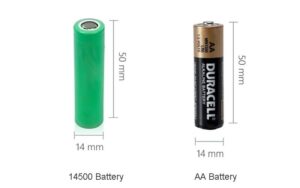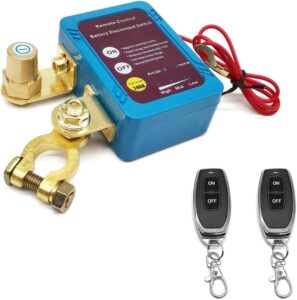Have you ever wondered how a AA battery works? Well, the answer is simpler than you might think. AA batteries are powerhouses that provide energy to a wide range of devices we use every day. From remote controls to flashlights, these compact cylindrical cells play a vital role in keeping our gadgets running smoothly. But how does a AA battery work exactly? In this article, we will dive into the science behind these batteries and unravel the mystery behind their ability to power our devices effectively and efficiently. So, let’s embark on this electrifying journey to understand the inner workings of a AA battery.
How Does a AA Battery Work?
A AA battery is a small, portable power source used in a wide range of devices, from remote controls to flashlights to digital cameras. Despite its compact size, this cylindrical cell packs a punch when it comes to delivering reliable electrical energy. In this article, we will explore the inner workings of a AA battery, discussing the different components and processes that make it function.
The Anatomy of a AA Battery
To understand how a AA battery works, let’s start by examining its structure. Although there are different types of AA batteries, we will focus on the most common one, the alkaline battery. Here are the main components:
1. Positive Terminal (Cathode): The top of the battery is the positive terminal, usually marked with a plus sign (+). It is made of a conductive material, such as carbon or silver oxide.
2. Negative Terminal (Anode): The bottom of the battery is the negative terminal, typically marked with a minus sign (-). It is also made of a conductive material, often zinc or zinc powder.
3. Electrolyte: Inside the battery, there is a paste-like substance called the electrolyte. It is a mixture of potassium hydroxide (KOH) and other chemicals that facilitate the flow of electric current.
4. Separator: The electrolyte is separated from the anode by a porous material called the separator. It acts as a barrier, preventing direct contact between the anode and the cathode, while allowing the movement of ions.
The Chemical Reactions
Now that we understand the basic structure of a AA battery, let’s delve into the chemical reactions that occur within it, enabling it to produce electricity. An alkaline battery relies on an oxidation-reduction (redox) reaction between the anode and the cathode. Here’s how it works:
1. At the anode (negative terminal):
– Zinc atoms react with hydroxide ions (OH-) from the electrolyte to form zinc oxide (ZnO) and release electrons.
– The chemical equation can be described as: Zn + 2OH- → ZnO + H2O + 2e-
2. At the cathode (positive terminal):
– Manganese dioxide (MnO2) in the cathode reacts with water and hydrogen ions (H+) from the electrolyte.
– The reaction results in the formation of manganese oxide (Mn2O3), water, and the consumption of electrons.
– The chemical equation can be represented as: MnO2 + H2O + H+ + e- → Mn2O3 + 2H2O
3. Overall reaction:
– By combining the anode and cathode reactions, we get the complete redox reaction for a AA battery:
– Zn + 2MnO2 → ZnO + Mn2O3
It’s worth noting that these chemical reactions are reversible, allowing the battery to be recharged in some cases.
Electric Current Flow
Now that the redox reaction has taken place, and electrons have been released at the anode, the battery is ready to produce an electric current. Here’s how the flow of electrons occurs within a AA battery:
1. At the anode:
– Electrons, being negatively charged, are repelled by the negative terminal and flow through the external circuit to reach the positive terminal.
2. Within the external circuit:
– The flow of electrons through the circuit can power various devices or be directed to perform useful work, such as lighting a bulb or operating a motor.
– The electrons travel through the circuit, providing the electrical energy needed to perform specific functions.
3. At the cathode:
– Once the electrons have completed their journey through the external circuit, they reach the cathode, where they combine with hydrogen ions and oxygen from the air to form water molecules.
4. Completion of the circuit:
– The flow of electrons from the anode to the cathode completes the circuit, allowing continuous electron flow and the sustained delivery of electrical energy.
Advantages and Limitations of AA Batteries
AA batteries offer several advantages that make them popular in many consumer devices:
– Portability: AA batteries are small and lightweight, making them easy to carry and replace when needed.
– Availability: AA batteries are widely available and can be found in most stores, making them convenient for immediate power needs.
– Compatibility: AA batteries have a universal design, allowing them to be used in a wide range of devices without requiring specialized connectors.
However, AA batteries also have some limitations:
– Disposal: Alkaline batteries can be harmful to the environment if not disposed of properly. It is important to recycle them or follow local regulations for their safe disposal.
– Limited Lifespan: AA batteries have a finite lifespan and will eventually run out of power. Rechargeable AA batteries can mitigate this limitation, but they require additional equipment for recharging.
In conclusion, a AA battery operates through a combination of chemical reactions that involve the anode, cathode, and electrolyte. The redox reaction releases electrons, which flow through an external circuit, providing electrical energy to power various devices. AA batteries are widely used due to their portability and compatibility, although they come with certain disposal and limited lifespan considerations. Understanding the inner workings of AA batteries gives us a better appreciation of these small but mighty power sources that are an integral part of our everyday lives.
Frequently Asked Questions
How does an AA battery work?
An AA battery works by converting chemical energy into electrical energy. It contains two electrodes, a positive electrode (called the cathode) and a negative electrode (called the anode), which are separated by an electrolyte made of a conductive solution or gel.
What materials are used in an AA battery?
An AA battery typically consists of a zinc metal casing that acts as the anode, a cathode made of a carbon rod surrounded by manganese dioxide, and an electrolyte solution containing potassium hydroxide.
How does the chemical reaction in an AA battery generate electricity?
The chemical reaction that powers an AA battery occurs between the zinc casing (anode) and the electrolyte solution. Zinc atoms oxidize and release electrons, resulting in the production of zinc ions. These electrons flow through an external circuit, creating an electric current.
What role does the cathode play in an AA battery?
The cathode, made of a carbon rod surrounded by manganese dioxide, acts as a catalyst in the chemical reaction. It helps facilitate the movement of electrons from the zinc anode to the external circuit, allowing a continuous flow of electric current.
Why does the voltage of an AA battery decrease over time?
The voltage of an AA battery decreases over time due to the chemical reactions happening inside. As the zinc anode slowly oxidizes, the available reactant decreases, resulting in a decrease in voltage output. This is why batteries eventually need to be replaced.
Can an AA battery be recharged?
Traditional alkaline AA batteries are not designed to be recharged. However, there are rechargeable AA batteries available, such as nickel-metal hydride (NiMH) batteries. These rechargeable AA batteries can be reused multiple times by applying electrical current to reverse the chemical reactions that occur during discharge.
Final Thoughts
The AA battery is a commonly used power source in many devices. It operates through a chemical reaction between its components: a positive terminal containing manganese dioxide and a negative terminal made of zinc. This reaction produces a flow of electrons, creating an electric current that powers the device. The electrolyte, usually potassium hydroxide, helps facilitate the movement of ions and balances the chemical reaction. As the battery is used, the chemicals gradually deplete, resulting in a decrease in voltage and power output. Understanding how a AA battery works can provide insight into its capabilities and limitations.



